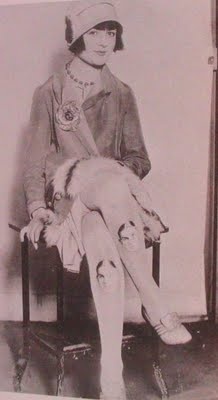 The Flapper Wife by Beatrice Burton (published 1925) is a marvelous find for me. It provides loads of information about the Roaring Twenties not easily found elsewhere. I picked up period language (“who is the sheik I saw leaving the house”, “What a poor simp Lola was!”, “you have it all over her like a tent”), historical details not found in history books (a punch is one-third fruit juice and two-thirds gin, women wore driving gloves in the car, a telephone is located in the coat closet under the stairs), clothing details (“she put on her kimono and went downstairs,”), information about medicine (milk toast and hot lemonade for a cold), makeup (removing it with a wad of cotton dipped in almond oil), food (a lettuce sandwich–no further explanation, but I assume is lettuce, bread, and some sort of mayonnaise?), and prices (a full-time maid earns $18/week, a very expensive hat is $55).
The Flapper Wife by Beatrice Burton (published 1925) is a marvelous find for me. It provides loads of information about the Roaring Twenties not easily found elsewhere. I picked up period language (“who is the sheik I saw leaving the house”, “What a poor simp Lola was!”, “you have it all over her like a tent”), historical details not found in history books (a punch is one-third fruit juice and two-thirds gin, women wore driving gloves in the car, a telephone is located in the coat closet under the stairs), clothing details (“she put on her kimono and went downstairs,”), information about medicine (milk toast and hot lemonade for a cold), makeup (removing it with a wad of cotton dipped in almond oil), food (a lettuce sandwich–no further explanation, but I assume is lettuce, bread, and some sort of mayonnaise?), and prices (a full-time maid earns $18/week, a very expensive hat is $55).
I also learned about attitudes in 1925, the year that my Roaring Twenties mysteries take place. Read on . . .
The miserably illogical and stupid plot centers around a 20-year-old who is just married. She’s grown up in a poor family, and somehow (inexplicably) has never learned to cook a meal or do any housework, not even dusting. She always telephones for her groceries; she’s never even been “to market.” This makes no sense and is never explained. So . . . anyway, she wants to marry a rich man, and she marries a young lawyer whom she doesn’t know well and turns out to be not rich at all. What attracted him to her is never explained; she’s pretty, but brainless. (Well, I guess he isn’t the first man to go for that combination.) They barely know each other. There is no pre-marital sex. She doesn’t even kiss him much. She is a wild “flapper” who wants to party and go to the pictures and have fun, and she is still in love with her previous boyfriend, a rotter (of course) who is a handsome, out-of-work actor (nothing worse than an actor).
Within a few weeks, this petulant, demanding young thing has gone through her new husband’s bank account, and he can’t suggest she stop spending because she’s so pretty. So he’s as big an idiot as she is. Anyway, after pages and pages of drivel and several separations, they manage to get back together. The moral that the author wants to drill into young women: women get their joy and fulfillment from cooking, cleaning, and having babies. (Everyone has been trying to tell her that throughout the book.) Once our young 20-year-old realizes that she’s been pursuing a flapper lifestyle rather than her true vocation, life is miraculously happily ever after. (Eye roll.) She chides her husband at the end, saying if he’d been stricter with her and disciplined her more, she’d have been better behaved. Amusingly, there is no hint of sex and the heroine, if she could be called that, hasn’t a clue, even as a married woman. When her actor-boyfriend kisses her and says he “wants her,” she wonders what on earth he can mean by that?
So did you think I disliked the book? Au contraire! I thoroughly enjoyed it! It’s like reading a slice of history, and very amusing history at that. My two grandmothers, who would be the same age as the empty-headed young woman in this story, were nothing like that, nor were their sisters or contemporaries that I knew. But the author, a mature woman, is reacting to the widespread concern that all this independence for young women was bad for them and for society. She’s helping to convince readers (other young women) that subservience to the superior male is the definition of a successful marriage.











![Downtown-image2_medium[1] - size 75](https://marymiley.files.wordpress.com/2015/11/downtown-image2_medium1-size-75.jpg)


